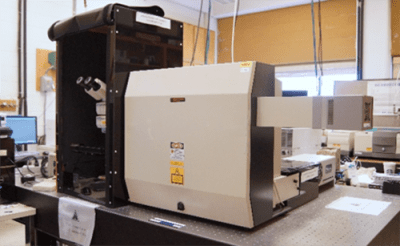
Sample Requirements
- Solid or liquid
- Only microscopic amounts needed
- Sample size limited only by clearance under microscope
Summary of Technique
Stimulating the sample with a laser causes a phenomenon called Raman scattering. This inelastic scattering allows for identification of functional groups and is considered complementary to infrared spectroscopy. In some cases it can also provide information on crystallinity, purity, stress & strain or defects.
Information Provided & Detection Limits
Raman is capable of determining the major organic chemical species present in a sample, with a detection limit of 1-5% by weight. An advantage to Raman microscopy versus infrared microscopy is the lack of sample preparation required and its ability to measure aqueous samples. However, Raman is an inherently weak phenomenon, and can be overcome by fluorescence in some cases.
Specifications
- 250 mm spectrometer focal length
- 1800 gr/mm grating
Lab Location and Contact Information
Lab Location: Science 1, G20
Lab Manager: Capri Price
capri.price@uconn.edu
860-486-5851